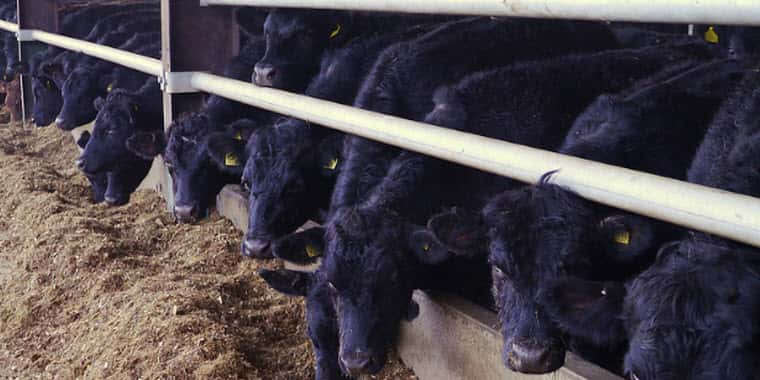By Jennifer Carrico, DTN Senior Livestock Editor
The fourth quarter of 2023 brought much price fluctuation for both feeder cattle and fat cattle, leading many to question if some risk marketing was affecting these abrupt changes. For some cattle producers, it helped save their operation, while others may be playing the system on both sides.
The Livestock Risk Protection (LRP) program has been around for nearly 20 years, but recent changes have added flexibility and incentive to use the product similar to how crop farmers use crop insurance to insure against a declining market.
Northwest Iowa farmer Craig Moss started using LRP in his hog operation in 2008, but it wasn’t until after the program was overhauled in 2019 that he started using it more and then started using it on the cattle side of his business.
“The guy who markets our hogs for us wanted to meet with us and our lender at the same time to discuss using LRP,” Moss said. “That’s how we got into using it in our hogs and now in our cattle too,” he said.
Moss said they have used it for the past couple years on the cattle side, mostly for basis management, which he said especially worked well recently when basis wasn’t great.
“Our lender and us have an understanding if we are going to use a lot of futures and options, we need to have a structured line of credit for that. LRP gave us the option to use it as margin management to guarantee ourselves on our fat cattle. It helps ensure we can see where we will be in the end,” he said.
REASONS FOR THE MARKET DOWNFALL
Lance Zimmerman, senior beef and cattle market analyst for Rabobank, said prices in the live and feeder cattle futures markets have gone through a significant correction lower over the last several months.
“Looking specifically at the April 2024 live cattle contract, prices have declined $34 per hundredweight from the September highs to the recent lows,” Zimmerman said. “That is a $500-per-head decline in prices in roughly three months. That magnitude of a price move causes all participants to take pause and assess what is happening in the marketplace.”
Zimmerman said risk managers have left some margin on the table by simply selling live cattle futures as they procured feeder cattle.
“You likely miss out on some of the market upside potential in exchange for avoiding some of the downside market risk,” he added.
The risk managers then had to look for more than one way to prevent a larger loss due to the fluctuating markets. Zimmerman explained one strategy would be selling a put option below the market, and as the market started to break, the risk managers may have needed to manage those positions, adding to some of the downside potential.
Some have discussed whether the increase in the use of USDA’s LRP program added to some of the recent downside. Even though the program has been around for 20 years, it had a slow start, and as recently as 2017, less than 100,000 head of cattle were enrolled in the program, according to Zimmerman. In 2023, that increased to more than 5 million cattle.
“The program absolutely has benefits to cattle producers, and it can serve as a valuable risk management tool for producers — especially smaller producers where futures or options markets are not always the best tool for price protection,” he said.
USING THE PROGRAM CORRECTLY WORKS
Brad Kooima, president of Kooima Kooima Varilek Trading in Sioux Center, Iowa, has been a cattle marketer for more than 40 years. He said several of his customers are using LRP as a marketing tool, and when it’s used for its intended purpose, it works well.
“The LRP contract is basically a put option,” Kooima said. “Fairly recently, the government decided to increase the subsidy, much like they do with crop insurance. They have increased the subsidy by 35%. This is very attractive to smaller producers or cow-calf producers looking for some protection.”
However, some people have been covering the cattle twice. Kooima described it in this way: “Some entities who have taken advantage of the program and have taken a $9 put option, which is covered 35% by the government subsidy, and then sell the exact same option back to the commodity broker for $9. Thus collecting $3 with no risk no matter what happens.”
Kooima said his partners, who are licensed to sell LRP, reached out to USDA’s Risk Management Agency (RMA) over a year ago to see if they knew people were doing this. The RMA called it “subsidy harvesting,” but they didn’t think it was a widespread practice. Kooima’s partners told RMA differently.
“Why should we care about the subsidy harvesting?” Kooima asked. “For me, it doesn’t pass the smell test and isn’t an ethical use of taxpayer’s money. If it’s used for the intended purpose, no problem, but this is not its intended purpose.”
He also pointed out another problem is that these people can spend more on feeder cattle because of their lower break even, and that could have extended and accelerated the recent break in the market.
Kooima said seeing the oddness of what happened when the markets went down like it did in November means a solution is needed to prevent it in the future. A simple revision of rules could help prevent these problems.
For producers like Moss, he hopes the LRP continues to be available, even during market dips like they recently experienced and had to write checks back to the LRP.
“We’ve never traded any options along with it, mostly because that’s another thing to manage, and time is something we have the least of,” he said. “The dollar amount per head we spend on LRP is sometimes sizeable, but it’s a guaranteed return, and we know it’s going to be there.”
###
DTN




